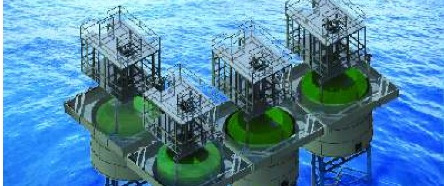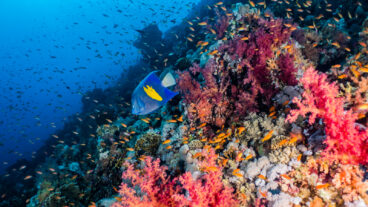It can harness 20 times more energy than any other wave technology in existence today and also produce carbon-free desalinated water. How? Israel’s Seanergy ‘holds the waves.’

To wean America off polluting and politically unstable foreign oil, government members and legislators are advocating technologies such as solar, wind, geothermal and also wave energy to develop new sources of power. President Obama is pushing for green jobs and Americans want them.
Inspired by children playing with a beach ball at the seaside, Shlomo Gilboa an Israeli politician-turned-inventor has invested millions of his own dollars in Seanergy, a new company and product that share a name. Seanergy harvests the energy of ocean waves through an offshore farm of buoys. It could be the next technology adopted by American utility companies, if Gilboa has his way.
In an interview with ISRAEL21c, Gilboa relates that the technology now being tested off the coast of Haifa can harness 20 times more power from wave energy than any other similar technology in existence today.
“Our harvesting system from the sea produces at least 20 times more energy than conventional or non-conventional buoys,” says Gilboa, who is also the company’s CEO. “In our system, we manage to ‘hold the wave’. Usually it’s come and gone in a second. But we manipulate it, holding the wave level in a reservoir in the buoy, to capture it.”
Popping up in a burst of power
The buoy literally shoots up when it reaches the crest of the wave: “With the same impact as when you take a ball and put it underwater in the swimming pool and it pops up in a huge burst of energy,” explains Gilboa. “We are harvesting this special energy. No other system in the world comes close.”
Seanergy is currently working with the Israel Electric Corporation and has been endorsed by engineers at the University of Haifa.
Gilboa says that while generating electric power, the system also produces a significant amount of carbon-free desalinated water. He estimates that a million cubic meters of desalinated water will be produced by a Seanergy farm that covers a 300 square meter (about 3,229 square foot) patch of water at sea. While traditional desalination plants can produce orders of magnitudes more water, unlike Seanergy they require an extensive amount of energy input to the system.
Currently a number of large and small companies around the world are negotiating with the company about a first facility, which will require a $2 million investment for four, four-buoy clusters. Gilboa says that according to the most conservative projection, the Seanergy buoy system, which sits below the surface of the waves and pops up as it collects energy, can pay for itself in feed-in tariffs within three years.
Making waves
To illustrate his point, Gilboa describes the Seanergy cluster in a region off the coast of Oregon in the US. Each buoy there can generate 1 megawatt of power, which over a year amounts to 200 to 250 kilowatts per cluster. According to the Cnet tech journal, that’s enough to power about 80 homes. The amount generated at any given site is a function of the wave action potential there.
Companies all over the world are attempting to capture the power of waves and there are a plethora of what appear to be zoologically-inspired prototypes that range from the bizarre to the sublime.
There are massive ‘snakes’ (655-foot-long anaconda devices), ‘oysters’ (large hydraulic flaps that open and close) and ‘dragons’ (contraptions with long arm-like devices that direct waves up a ramp toward an offshore reservoir). The weird-looking snakes move hypnotically through the waves.
Of these, Gilboa credits potential competitors such as the Scottish-based Pelamis and New Jersey’s Ocean Power Technologies as two wave technology companies that “add real value to the market.”
15 years of development
Seanergy presented its prototype at the “Innovation” pavilion in the Industry, Trade and Labor Ministry’s NEWTech division for the estimated 19,000 people who attended the international Watec conference in Tel Aviv in November. NEWTech promotes Israeli water technologies worldwide.
Although the company was officially formed in 2008, the idea has been in development for about 15 years, and millions of dollars of personal financing were invested in the prototype. Based in Haifa, Seanergy employs a small staff of four, but has worked with more than 100 consultants and specialists to get its prototype to ‘float.’
At the Haifa National Museum of Science Seanergy is presented as an important and radical new green technology. In the near future, you may see its buoys bouncing around a coast near you.













